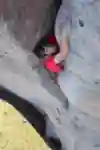Jimmy Chin is a renowned director, cinematographer and National Geographic photographer and has used his passions of skiing and climbing to get him where he is today. Below he shares five essential points that helped shape his career and kept him alive in the mountains. These include the importance of following one’s passion, knowing limits and knowing when to turn around – especially when it comes to avy (avalanche) risk. He also stressed the importance of keeping a sharp physical and mental edge, paying dues and mentorships.
1. Being passionate and following your life’s trajectory
I still love being in the mountains, the ocean and being outside. Climbing, skiing and surfing fulfil something primal for me. Winning an Oscar [for Free Solo] actually reinforced that. That was an important achievement for me, but the most powerful and meaningful experiences I’ve found have still been on expeditions and in wild, remote landscapes.
2. Knowing when it’s time to turn around
I just got off an expedition to Antarctica. It was my second time there in two years. Conrad Anker, Jim Morrison, and Hilaree Nelson and I climbed the highest peak in Antarctica, Mount Vinson (16,050ft/4,892m), by a route called the Central Ice Stream in a single push. We landed at Vinson base camp, put our gear together, got up the next morning and climbed 10,000 plus feet (over 3,048m) in knee-deep snow. We were going to ski our climbing line but avy conditions were unacceptably high, so we skied an easier, safer line. There is always a lot of pressure as a professional athlete to do things no one has ever done before, but you have to be able to step outside of that pressure and make the right decisions to stay alive. It was still an amazing climb, and we were in out of basecamp in 48 hours.
Then we spent a few weeks trying to climb and ski Mount Tyree (15,919ft/4,852m), which is the second-highest peak in Antarctica but is technically more difficult than Vinson. Avy conditions were again too high, so we turned around. It was one of the biggest snow years anyone had seen down there. It’s very rare to have those kind of avy conditions down there.
3. Keeping a sharp mental and physical edge
That’s probably one of the hardest things to maintain in my career – keeping that physical and mental edge to be in the mountains. Because of my travel schedule, productions and shoots, I have to put a lot of effort into staying fit mentally and physically. I train a lot on the road, in my hotel room, at climbing gyms, etc., but the best thing for climbing and skiing and being in the alpine is still getting out and doing it. I try to set aside time every month at home in Jackson (in the Tetons), which is perfect for charging in the mountains. It’s the same with filming and photography. By doing it, I keep those creative muscles in shape as well.
4. Paying dues
If you really want to make it happen, you have to just go out and do it. It’s about paying your dues and doing the hard work. You’re entitled to nothing. The greatest risk I took was doing what I really love. Everyone thought the prospects of being a professional climber and photographer as a career seemed very, very slim. When I started, I didn’t know you could make a living as a professional athlete. Now it’s a lot more mainstream. Now it’s possible.
5. The importance of mentors
It’s not about finding your mentors; they find you. Mentors can tell when people are doing something for the right reasons – because they are passionate about it, because they love it. It’s not about fame, how many likes you get. It’s about doing it because you can’t not do it. You have to put in the time before mentors are going to invest time in you. You have to earn that person.






